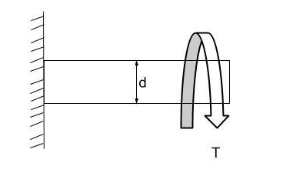
The value of angle of twist at the clamped end of a rod is
a) 90o
b) 180o
c) 60o
d) 0o
Answer
564k+ views
Hint:In order to twist a free rod twisting moment is applied at its both ends in the opposite direction. As we know that a force applied on a rigid body causes a linear deformation in the body. Similarly, a twisting moment causes some angular deformation in the rod. This angular deformation caused in the rod due to the application of twisting moment is known as angle of twist.
Complete step by step answer:
Now consider a rod of diameter d, clamped at one of its ends as shown in the figure given below. A twisting moment T is applied at its free end. Let $\phi $be the angle of twist caused due to the twisting moment T.

Now as one of its ends is clamped and the twisting moment is applied on the free end, the free end will rotate to some angle due to the application of twisting moment. However, the other end is fixed because of the clamping, hence it is unable to rotate. Hence, the clamped end does not have any angular deformation whereas the free end being free to rotate undergoes the angular deformation.
In other words, the value of angle of twist at the clamped of the rod is zero (0o) and it varies uniformly towards the other end of the rod. Hence, option D is the correct answer option.
Note:The twisting moment is also known as torsion. It is a key factor in designing shafts for automobiles. A good shaft must not break under the effect of a twisting moment hence a safe value of twisting moment to which the shaft can be subjected is calculated by the following formula.
$\dfrac{T}{J} = \dfrac{\tau }{r} = \dfrac{{C\phi }}{L}$
Where, J is the polar moment of inertia, $\tau $ is the shear stress, r & L are the radius & length of shaft or rod respectively.
Complete step by step answer:
Now consider a rod of diameter d, clamped at one of its ends as shown in the figure given below. A twisting moment T is applied at its free end. Let $\phi $be the angle of twist caused due to the twisting moment T.

Now as one of its ends is clamped and the twisting moment is applied on the free end, the free end will rotate to some angle due to the application of twisting moment. However, the other end is fixed because of the clamping, hence it is unable to rotate. Hence, the clamped end does not have any angular deformation whereas the free end being free to rotate undergoes the angular deformation.
In other words, the value of angle of twist at the clamped of the rod is zero (0o) and it varies uniformly towards the other end of the rod. Hence, option D is the correct answer option.
Note:The twisting moment is also known as torsion. It is a key factor in designing shafts for automobiles. A good shaft must not break under the effect of a twisting moment hence a safe value of twisting moment to which the shaft can be subjected is calculated by the following formula.
$\dfrac{T}{J} = \dfrac{\tau }{r} = \dfrac{{C\phi }}{L}$
Where, J is the polar moment of inertia, $\tau $ is the shear stress, r & L are the radius & length of shaft or rod respectively.
Recently Updated Pages
Why are manures considered better than fertilizers class 11 biology CBSE

Find the coordinates of the midpoint of the line segment class 11 maths CBSE

Distinguish between static friction limiting friction class 11 physics CBSE

The Chairman of the constituent Assembly was A Jawaharlal class 11 social science CBSE

The first National Commission on Labour NCL submitted class 11 social science CBSE

Number of all subshell of n + l 7 is A 4 B 5 C 6 D class 11 chemistry CBSE

Trending doubts
What is meant by exothermic and endothermic reactions class 11 chemistry CBSE

10 examples of friction in our daily life

One Metric ton is equal to kg A 10000 B 1000 C 100 class 11 physics CBSE

1 Quintal is equal to a 110 kg b 10 kg c 100kg d 1000 class 11 physics CBSE

Difference Between Prokaryotic Cells and Eukaryotic Cells

What are Quantum numbers Explain the quantum number class 11 chemistry CBSE




